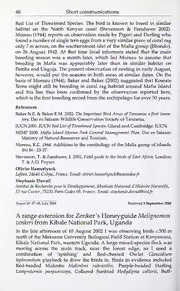
A range extension for Zenker's honeyguide Melignomon zenkeri from Kibale National Park, Uganda PDF
Preview A range extension for Zenker's honeyguide Melignomon zenkeri from Kibale National Park, Uganda
48 Short communications Red List of Threatened Species. The bird is known to breed in similar habitat on the North Kenyan coast (Stevenson & Fanshawe 2002). Moreau (1944) reports an observation made by Pigott and Darling who found a number ofsingle tern eggs from a very similar piece of coral rag m only 7 across, on the southernmost islet of the Mafia group (Jibondo), on 26 August 1942. At that time local informers stated that the main breeding season was a month later, which led Moreau to assume that breeding in Mafia was appreciably later than in similar habitat on Pemba and Unguja. The present observation of nesting in early August, however, would put the seasons in both areas at similar dates. On the basis of Moreau (1944), Baker and Baker (2002) suggested that Roseate Terns might still be breeding in coral rag habitat around Mafia Island and this has thus been confirmed by the observation reported here, whichis the firstbreeding record from the archipelago for over 50 years. References Baker N.E. & Baker E.M. 2002. TheImportant BirdAreas ofTanzania: afirst inven- tory. Dar es Salaam: WildlifeConservationSociety ofTanzania. lUCN2000. lUCNRed ListofThreatened Species. Gland and Cambridge: lUCN. MIMP 2000. Mafia Island Marine Park General Management Plan. Dar es Salaam: Ministry ofNaturalResources and Tourism. Moreau, R.E. 1944. Additions to the ornithology of the Mafia group of islands. Ihis 86 : 33-37. Stevenson, T. & Fanshawe, J. 2002. Fieldguide to the birds ofEast Africa. London: T. &A.D. Poyser. OlivierHamerlynck Lafont, 24640 Cubjac, France. Email: [email protected] Stephanie Duvail InstitutdeRecherchepourle Developpement, Museum National d'HistoireNaturelle, 57 rue Cuvier, 75231 Paris Cedex 05, France. Email: Stephanie.duvail@irdfr Scopus24:47-48,July2004 Received5September2003 A range extension for Zenker's Honeyguide Melignomon zenkeri from Kibale National Park, Uganda m In the late afternoon of 10 August 2002 I was observing birds c.500 north of the Makarere University Biological Field Station at Kanyawara, Kibale National Park, western Uganda. A large mixed-species flock was moving across the main track, near the forest edge, so I used a combination of 'spishing' and Red-chested Owlet Glaucidium tephronotum playback to draw the birds in. Birds in evidence included Red-headed Malimbe Malimbus rubricollis, Purple-headed Starling Lamprotornis purpureiceps, Collared Sunbird Hedydipna collaris, Buff- Short communications 49 throated Apalis Apalis rufogularis, Yellow-whiskered Greenbul Andropadus latirostris and many others. Many birds approached, showing aggravation and, since the canopy and midstorey of the forest were fairly open, I could observe many of them clearly The white outer tail feathers of a bird caught my attention m as it dropped down from the lower canopy (c.15-20 high) and m m perched less than 5 away, c.5-6 up. It held its body horizontally, and moved its body from side to side, presumably an indication of its agitation. Given the bird's size (similar to that of a Lesser Honeyguide Indicator minor), I expected it was a Thick-billed Honeyguide Indicator conirostris, a species I had heard calling daily over the previous week. The bird was rather stocky, with a medium-length tail, of medium breadth along its entire length, shortish, broad neck and small head. The general colouration was a dull olive with a slightly greyer head, orangey-yellow legs and a medium-length, black, rather fine bill, dissimilar in shape to that of any Indicator species. Superficially the bird most closely resembled a Little Greenbul Andropadus virens in appearance. When the bird flew back up towards the lower canopy the white outer tail feathers were once again conspicuous. I continued to 'spish', managing to attract the bird once more to verify my observations. This time I also noted a yellowish tinge to the undertail coverts. The combination of these features fits only Zenker's Honeyguide (Borrow & Demey 2001; Fry etah 1988). Zenker's Honeyguide is a scarce lowland forest species, which occurs from southern Cameroon to western Uganda, through much of the Congo Basin. It is reported to prefer secondary situations and forest edge (Borrow & Demey 2002) up m to 1530 (Fry et al. 1988). The only previous east African records come from the Bwamba Lowlands/Semliki Valley, on the western border of Uganda (Fry et al. 1988). This constitutes a new record for Kibale National Park and an eastward extension of the previously known range of this secretive forest honeyguide. Coming from an altitude of C.1500 m, this record also comes from near the upper altitudinal range reported for this species. References Borrow, N. & Demey, R. 2002. Birds of Western Africa. Londor\: Christopher Helm. Fry, CH., Keith, S. & Urban, E.K. 1988. The Birds ofAfrica, Volume 3. London: AcademicPress. Michael Mills PercyFitzpatrickInstituteofAfrican Ornithology, University ofCape Town, Rondebosch 7701, SouthAfrica. Email: [email protected] Scopus24:48-49,July2004 Received25October2002
